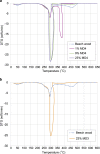Selection and Use of Manganese Dioxide by Neanderthals
- PMID: 26922901
- PMCID: PMC4770591
- DOI: 10.1038/srep22159
Selection and Use of Manganese Dioxide by Neanderthals
Abstract
Several Mousterian sites in France have yielded large numbers of small black blocs. The usual interpretation is that these 'manganese oxides' were collected for their colouring properties and used in body decoration, potentially for symbolic expression. Neanderthals habitually used fire and if they needed black material for decoration, soot and charcoal were readily available, whereas obtaining manganese oxides would have incurred considerably higher costs. Compositional analyses lead us to infer that late Neanderthals at Pech-de-l'Azé I were deliberately selecting manganese dioxide. Combustion experiments and thermo-gravimetric measurements demonstrate that manganese dioxide reduces wood's auto-ignition temperature and substantially increases the rate of char combustion, leading us to conclude that the most beneficial use for manganese dioxide was in fire-making. With archaeological evidence for fire places and the conversion of the manganese dioxide to powder, we argue that Neanderthals at Pech-de-l'Azé I used manganese dioxide in fire-making and produced fire on demand.
Figures




Similar articles
-
The age of three Middle Palaeolithic sites: Single-grain optically stimulated luminescence chronologies for Pech de l'Azé I, II and IV in France.J Hum Evol. 2016 Jun;95:80-103. doi: 10.1016/j.jhevol.2016.03.010. Epub 2016 May 20. J Hum Evol. 2016. PMID: 27260176
-
Climate-mediated shifts in Neandertal subsistence behaviors at Pech de l'Azé IV and Roc de Marsal (Dordogne Valley, France).J Hum Evol. 2016 Jul;96:1-18. doi: 10.1016/j.jhevol.2016.03.009. Epub 2016 May 4. J Hum Evol. 2016. PMID: 27343769
-
The Pech-de-l'Azé I Neandertal child: ESR, uranium-series, and AMS 14C dating of its MTA type B context.J Hum Evol. 2007 Apr;52(4):455-66. doi: 10.1016/j.jhevol.2006.11.006. Epub 2006 Dec 10. J Hum Evol. 2007. PMID: 17284331
-
Keeping Children Safe: a multicentre programme of research to increase the evidence base for preventing unintentional injuries in the home in the under-fives.Southampton (UK): NIHR Journals Library; 2017 Jul. Southampton (UK): NIHR Journals Library; 2017 Jul. PMID: 28771290 Free Books & Documents. Review.
-
Gaseous Heterogeneous Catalytic Reactions over Mn-Based Oxides for Environmental Applications: A Critical Review.Environ Sci Technol. 2017 Aug 15;51(16):8879-8892. doi: 10.1021/acs.est.6b06079. Epub 2017 Jul 17. Environ Sci Technol. 2017. PMID: 28662330 Review.
Cited by
-
Full Chromosomal Relationships Between Populations and the Origin of Humans.Front Genet. 2022 Feb 2;12:828805. doi: 10.3389/fgene.2021.828805. eCollection 2021. Front Genet. 2022. PMID: 35186019 Free PMC article.
-
Language, Childhood, and Fire: How We Learned to Love Sharing Stories.Front Psychol. 2022 Jan 27;12:787203. doi: 10.3389/fpsyg.2021.787203. eCollection 2021. Front Psychol. 2022. PMID: 35153908 Free PMC article. Review.
-
The ecology and bioactivity of some Greco-Roman medicinal minerals: the case of Melos earth pigments.Archaeol Anthropol Sci. 2021;13(10):166. doi: 10.1007/s12520-021-01396-z. Epub 2021 Sep 17. Archaeol Anthropol Sci. 2021. PMID: 34721705 Free PMC article.
-
Neanderthals and Homo sapiens had similar auditory and speech capacities.Nat Ecol Evol. 2021 May;5(5):609-615. doi: 10.1038/s41559-021-01391-6. Epub 2021 Mar 1. Nat Ecol Evol. 2021. PMID: 33649543
-
Diversity in the Family of Manganese Oxides at the Nanoscale: From Fundamentals to Applications.ACS Omega. 2020 Oct 5;5(40):25493-25504. doi: 10.1021/acsomega.0c03455. eCollection 2020 Oct 13. ACS Omega. 2020. PMID: 33073076 Free PMC article. Review.
References
-
- McBrearty S. & Brooks A. The revolution that wasn’t: A new interpretation of the origin of modern human behaviour. J. Hum. Evol. 39, 453–563 (2000). - PubMed
-
- Henshilwood C. S. & Marean W. W. The origin of modern human behaviour: Critique of the models and their test implications. Curr. Anthropol. 44, 627–651 (2003). - PubMed
-
- D’Errico F. et al.. in Becoming eloquent: Advances in the emergence of language, human cognition, and modern cultures (eds d’Errico F. & Hombert J.-M.) 13–68 (John Benjamins Publishing Company, 2009).
-
- Bordes F. H. Mousterian cultures in France. Science 134, 803–10 (1961). - PubMed
-
- Bordes F. H. A Tale of two caves.(Harper and Row Publishers, 1972).
Publication types
LinkOut - more resources
Full Text Sources
Other Literature Sources


